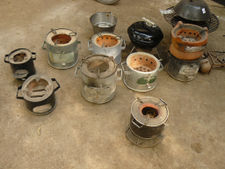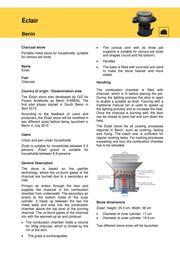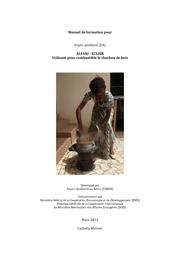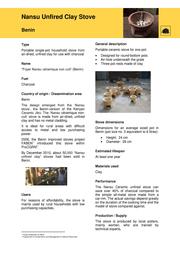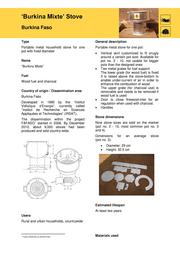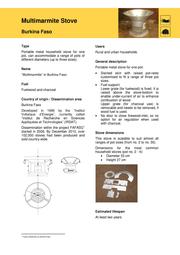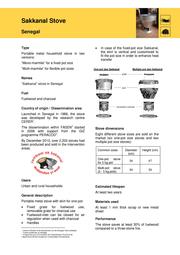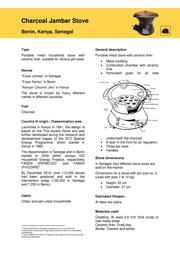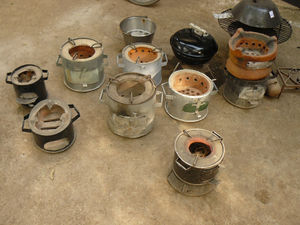Knowledge fuels change
For over a decade, Energypedia has shared free, reliable energy expertise with the world.
We’re now facing a serious funding gap.
Help keep this platform alive — your donation, big or small, truly matters!
Thank you for your support
Charcoal Cookstoves
Basics | Policy Advice | Planning | Designing and Implementing (ICS Supply)| Technologies and Practices | Designing and Implementing (Woodfuel Supply)| Climate Change
Introduction
Charcoal is charred wood, which has lost most volatiles in the production process and has a low moisture content. Thus it emits far less particles when burnt as compared to wood-fire. It is an energy-dense light-weight (on energy value per weight), easy-to-handle, and therefore convenient fuel, which burns without producing much smoke other than during lighting. These properties make it a preferred fuel especially in urban and peri-urban areas. For more information on charcoal as a fuel see Cooking with Charcoal.
Few people make their own charcoal. It is mostly produced in rural areas in portable or fixed kilns as an income generating activity. It is then usually sold into the more urban areas where firewood collection is less feasible and people have more purchasing power to buy fuel.
The main disadvantage of charcoal is its highly inefficient production process: more than half of the wood’s energy content is lost without further use during the charring process.[1] To produce 1 kg of charcoal in a traditional kiln 8-12 kg of wood are needed. See also the article and illustrations on charcoal production.
Charcoal Stoves
Charcoal stoves are mostly lightweight, portable and have generally one fire per pot. They are batch-fed, which means that all fuel required is filled in a container and lit at the start of the cooking process. Heat from charcoal is mainly transferred through radiation. This requires that the cooking pot sits close to the surface of the fuel, making the combustion chamber rather shallow.
Most traditional charcoal stoves are made of scrap metal with no option to regulate the burn-rate of the fuel and often without pot-rests, so that the pot sits directly on the charcoal. This causes high emissions of potentially lethal carbon monoxide and wastes a lot of fuel, as carbon monoxide is unburnt fuel with a high energy value. The inability to regulate the air supply and turn down the heat during the simmer-phase also leads to unnecessary waste of fuel.
In Africa, the most widespread example of an improved charcoal stove is the Kenyan Ceramic Jiko (KCJ). This stove type has a ceramic liner in a metal cladding. The ceramic liner protects the outer metal structure from deterioration by the fire. It also provides improved insulation, leading to a hotter flame and thus to a better efficiency. It has pot-rests creating a small gap between the charcoal and the pot, to allow some of the produced carbon-monoxide to burn off. Combustion is thus improved and less dangerous smokes emitted. Due to these design characteristics and depending on proper use and maintenance the stove can save between 30-50 % of charcoal compared to traditional charcoal stoves and reduce toxic emissions.[2] In Kenya, improved charcoal stoves are found in about 47% of all households, in Nairobi and Mombasa penetration rate is around 80% (2004 estimate).[3] As charcoal is usually purchased, users see the monetary benefit of saving fuel, which has made this stove model an economic success.
Similar designs have been replicated in many parts of Africa in the last two decades, sometimes with such success that in Eastern Africa, for example, they can be considered the new baseline technology.
Original KCJ's being distributed through a regional supermarket chain (Nakumatt):
Recent efforts to design even more efficient charcoal stoves than the KCJ include light-weight designs made of metal only. These are relevant for areas where suitable clay is lacking or where it is found challenging to combine metal and ceramic workers to produce one common product.
Improvements
Charcoal stoves can be improved in terms of durability and better heat use. The main agent which controls the burning of charcoal is air. To regulate the heat output, the airflow must be adjustable.
Charcoal radiates to all directions, not only upwards towards the pot. Thus it is crucial to minimize heat loss to the bottom and the sides of the stove. Cleverly designed air circulation in the stoves can recycle heat and create draft needed for efficient combustion.
Although radiation decreases exponentially with the distance, the pot must not be put directly on the glowing char. A gap should be allowed where ideally fresh secondary air can be directed above the charcoal to ensure a complete combustion of the carbon monoxide. This reduces emissions and increases fuel efficiency.
Summary of desired features:
- durability
- appropriate insulation or recovery of the radiated heat
- high and adjustable airflow to maximize combustion
- low emissions of carbon monoxide
Examples of Charcoal Stoves
|
Éclair, Benin (2012) | |
|
Nansu Unfired Clay Stove, Benin (2011) | |
|
Burkina Mixte, Burkina Faso (2011) | |
|
Multimarmite Stove, Burkina Faso (2011) | |
|
Sakkanal, Senegal (2011) | |
|
Jambar Stove, Charcoal, Benin, Kenya, Senegal (2011) | |
Kenyan Ceramic Jiko, Kenya ►History and data on the KJC: Research, Development and Commercialization of the Kenya Ceramic Jiko and other Improved Biomass Stoves in Africa (HORIZON INTERNATIONAL SOLUTIONS SITE) | |
Further Information
References
This article was originally published by GIZ HERA. It is basically based on experiences, lessons learned and information gathered by GIZ cook stove projects. You can find more information about the authors and experts of the original “Cooking Energy Compendium” in the Imprint.
- ↑ http://www.appropedia.org/Rocket_stove_biomass_charcoal#cite_note-Improved-8
- ↑ Research, Development and Commercialization of the Kenya Ceramic Jiko and other Improved Biomass Stoves in Africa: http://www.solutions-site.org/node/50
- ↑ USAID/Winrock International (2011): http://www.relwa.org/sites/default/files/Kenya-Stoves-Assessment-web.pdf


